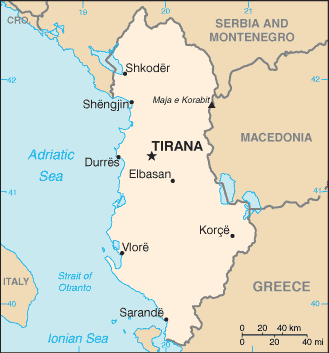Map:

Overview:
Between 1990 and 1992 Albania ended 46 years of xenophobic Communist rule and established a multiparty democracy. The transition has proven difficult as successive governments have tried to deal with high unemployment, widespread corruption, a dilapidated infrastructure, powerful organized crime networks with links to high government officials, and disruptive political opponents. International observers judged parliamentary elections in 2001 and local elections in 2003 to be acceptable and a step toward democratic development, but identified serious deficiencies. Many of these deficiencies have been addressed through bi-partisan changes to the electoral code in 2003 and 2005, but implementation of these changes will not be demonstrated until parliamentary elections in July 2005.
The People:
Population:
3,563,112 (July 2005 est.)
Age structure:
0-14 years: 25.6% (male 476,989/female 434,298)
15-64 years: 65.8% (male 1,199,964/female 1,144,886)
65 years and over: 8.6% (male 141,559/female 165,416) (2005 est.)
Religions:
Muslim 70%, Albanian Orthodox 20%, Roman Catholic 10%
note: percentages are estimates; there are no available current statistics on religious affiliation; all mosques and churches were closed in 1967 and religious observances prohibited; in November 1990, Albania began allowing private religious practice
Government Type:
emerging democracy
Leader(s) to pray for:
chief of state: President of the Republic Alfred MOISIU (since 24 July 2002)
head of government: Prime Minister Fatos NANO (since 31 July 2002)
Source: The World Factbook
View All Countries